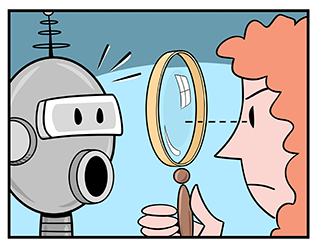How To Spot Bots

After reading about the sneaky tactics used by bots to spread messages and influence online conversations, you might wonder how to distinguish bots from authentic, human users. There is no single identifying characteristic of a bot account, but researchers have identified multiple characteristics that can help you recognize a bot. There are even some tools that predict the authenticity of a user. This page will identify a few tell-tell signs of bots and highlight helpful resources for the savvy social media user.
While these sophisticated bots are becoming more advanced by the minute, there are also many simple bots that are quite easy to identify. Being aware of the function that a specific bot might serve can be helpful when determining the authenticity of the account.
General Characteristics of Bots
Most bots have the following characteristics:
- Stock image profile picture. This may be a picture of nature, a cartoon, a political image, a celebrity or a provocative picture. Always run a reverse Google search of the image if you are unsure. You can do this by dragging an image from the web into the Google search box.
- Missing profile picture. Because it can be tricky to find an original profile picture, many accounts just have the default Twitter egg or silhouette of a person on Facebook.
- Longer usernames. Many bots have usernames that a human user would not choose. These usernames usually have a lot of numbers in them or make little sense.
- Overly simple or repetitive Tweets or Posts. The job of many bots is to make a certain topic (or hashtag) trend. Bots accomplish this by posting the same message repetitively.
- Accounts lack personality. While humans can have bright personalities, bots cannot. This is reflected in their profiles. Bot profiles may lack bio information or give generic responses to the “about” section on Facebook. 1
- Bots follow many more people than they are followed by. Because many people want to build the number of followers that they have, if a bot requests to follow them, they might allow it. However, because the user does not know the bot, it is unlikely that they will follow them back. So, many bots are following many more people than they are followed by.
- Post more than a human would. Bots don’t have a bedtime! As software, bots are able to run non-stop. Therefore, they never need to take breaks to eat or sleep. Some bots are set on timers to make it appear that they are taking breaks from online accounts, however, if an account posts a ton of content or never takes any breaks, it is likely a bot.
- Account shares the most radical messages. Bots are most likely overly patriotic and identify with the furthest extremes of the political spectrum. Whether they display militaristic nationalism or urge revolution, bots commonly disseminate extreme viewpoints. Of course, this doesn’t mean that everyone who expresses extreme ideas is necessarily a bot. This is just one of many possible indicators.
- Account feeds includes an unusual amount of filler posts. To conceal their political agenda, many bots post filler content, like animal videos or inspirational quotes, in between elections or events.1
- Account features stolen content. To attract a large audience to their site, some websites will repost content that originally appeared on a different news site. Bots often spread links to sites that feature this stolen news. 2
References
1 Digital Forensics Lab (2017, August 8) “#BotSpot: Twelve Ways to Spot a Bot,” DFRLab.
2 Bill Fitzgerald and Kris Shaffer (2017, June 5) “Spot a bot: Identifying automation and disinformation on social media,” Data for Democracy.
3 Bill Fitzgerald and Kris Shaffer (2017, June 5) “Spot a bot: Identifying automation and disinformation on social media,” Data for Democracy.
